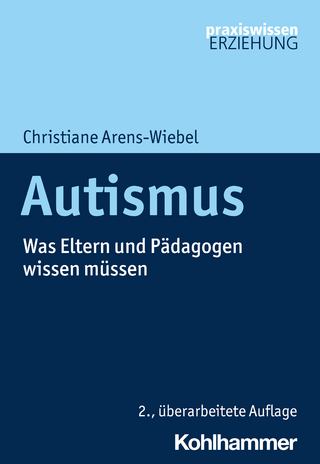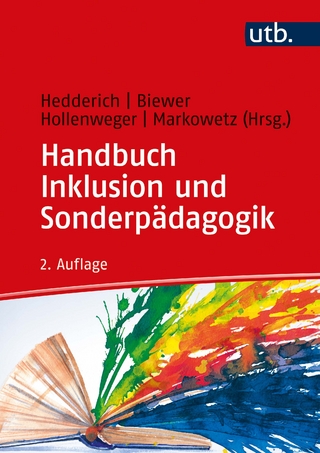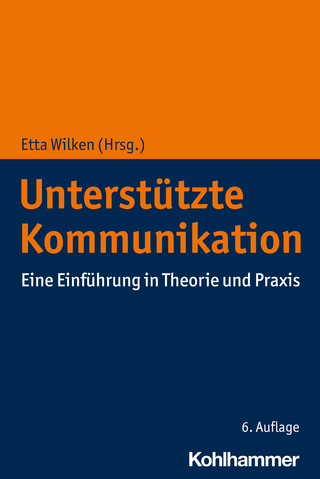
Teaching Students with Emotional and Behavioral Disorders
Plural Publishing Inc (Verlag)
978-1-63550-225-1 (ISBN)
Teaching Students with Emotional and Behavioral Disorders provides a comprehensive resource for preservice and in-service educators to teach and support academic, social, and behavioral development. The text focuses on implementation of evidence-based interventions, strategies, and practices. Dedicated chapters address quality service delivery models including individual, classroom, and school-wide supports. In addition, academic intervention chapters concentrate on reading, mathematics, writing, and study skills. Finally, the book includes step-by-step directions for conducting Functional Behavior Assessments (FBA), developing Behavior Intervention Plans (BIP), and monitoring student progress. The book will serve as a valuable reference for educators supporting students with challenging behaviors.
Key Features
Case studies written by PreK-12 practitioners based on their experiences supporting students with EBD
Numerous worksheets and examples to support implementation of evidence-based practices
Accessible and consistent format across all chapters
Pedagogical aids reinforce understanding: chapter objectives, key terms, chapter summaries, discussion questions, and lists of additional resources and readings
A PluralPlus companion website with instructor resources including PowerPoints, test banks, and sample class activities and student resources including links to videos, online learning modules, and printable forms
Brittany L. Hott, PhD is an Associate Professor of Special Education at the University of Oklahoma. She teaches assessment and interventions methods courses for the Department of Educational Psychology. Dr. Hott’s interests include school-based interventions, evidence-based practice, and single case research design. Dr. Hott is a multiple ironman finisher and Boston marathon qualifier.++++++++++++++++++++++++++++++++++++++++++++++++++++++Kathleen M. Randolph, PhD, BCBA-D is an Assistant Professor at the University of Colorado Colorado Springs. Her research interests include coaching teachers to increase use of evidence-based practices in classroom management, applied behavior analysis, and support students with emotional and behavior disabilities in the general education classroom. She enjoys running, coaching, and spending time with her family in her spare time.+++++++++++++++++++++++++++++++++++++For the past 25 years, Lesli Raymond, MS has worked as an educator in the same large, suburban school district she attended as a public school student. She currently works as an educational diagnostician at two elementary school campuses and has taught both general and special education at the elementary, middle, and high school levels. Her research interests include evidence-based interventions for teaching students with disabilities as well as algebra readiness interventions for students with or at risk for mathematics disabilities. In her leisure time, Lesli enjoys visiting National Parks and camping with her husband and two teenage children.
Introduction
Contributors
Chapter 1. Teaching Students with Emotional and Behavioral Disabilities
Introduction
Social Maladjustment
CoMorbidity/CoMorbid Disabilities
Learning Disability
Autism Spectrum Disorder (ASD)
Attention Deficit Hyperactivity Disorder
Intellectual Disability
Communication Disorders
Rationale for Inclusive Education
Evidence-Based Practices
Disproportionality
Disproportionality versus Overrepresentation
Determining Disproportionality
Theories Behind Disproportionality
Risk Factors
Federal Laws
Educational Placement
Impact of EBD
Recommendations to Address Disproportionality
Culturally Responsive Teaching
Implementation of RtI Practices
Universal Screening
Classroom Contexts
Chapter Summary
Discussion Questions
Resources
Evidence Based Practices Evidence-Based Practices
Person-First Language
Calculating Disproportionality
Determining Social Maladjustment
References
Chapter 2. Educating Students with EBD within School-wide Systems of Support
Introduction
Differentiated Instruction
Implementing Differentiated Instruction
Universal Design for Learning
Engagement
Representation
Action and Expression
Implementing UDL
Differentiated Instruction and Universal Design for Learning
Response to Intervention
Tier 1 – Core Instruction
Tier 2 – Targeted Support
Tier 3 – Intensive Intervention
Child Study
Positive Behavioral Interventions and Supports
Tier 1
Tier 2
Tier 3
Chapter Summary
Discussion Questions
References
Appendix 2–1. Self-Monitored Behavior Chart
Appendix 2–2. UDL Planning
Appendix 2–3. UDL Lesson Plan
Appendix 2–4. Child Study Team Process Step 1
Appendix 2–5. Child Study Process Step 2
Appendix 2–6. Child Study Process Step 3
Appendix 2–7. Middle School Referral Form
Appendix 2–8. Primary Referral Form
Appendix 2–9. Intervention Plan and Documentation
Appendix 2–10. Strategy and Intervention Record
Appendix 2–11. PBIS Office Referral Minor Offense
Appendix 2–12. PBIS Office Referral Major Offense
Chapter 3. Service Delivery
Introduction
What Drives Services For Students With EBD?
Free Appropriate Public Education
Least Restrictive Environment
Service Delivery Options
Inclusion
Co-Teaching
Resource Room
Center-Based Schools
Specially Designed Instruction
Classroom Management
Related Services for Students with EBD
Speech-Language Pathology
Physical and Occupational Therapy
Counseling Services
Mental Health Services
Related Legislation
Family Involvement in the IEP and Service Delivery Process
Barriers to Collaboration with Parents
Communication with Parents Beyond the IEP
Proportional Approaches to Service Delivery
Case Study–Elementary
Case Study–Secondary
Chapter Summary
Discussion Questions
Resources
References
Appendix 3–1. Example of a Token Board for a Student with EBD in an Elementary Math Class
Appendix 3–2. Check Sheet for a High School Student with EBD
Appendix 3–3. Home-School Communication Log
Appendix 3–4. Example Documentation for Parent Contact
Chapter 4. Mathematics Strategies and Interventions
Introduction
Challenges in Teaching Math to Students with EBD
Components of Effective Math Instruction for Students with EBD
Direct, Explicit, and Systematic
CRA Sequence
Daily Review and Repeated Practice
Scaffolded Support
Verbal Responses
Choral Responses
Think-Pair-Share
Non-Verbal Responses
Written Responses
Guided Notes
Pair and Write and Peer Guided Pause
Chalk Talk
Action Responses
Touching
Pointing
Hand Signals
Case Study
Math Interventions and Strategies for Students with EBD
Basic Numeracy Interventions and Strategies
Computation and Math Fact Fluency Interventions and Strategies
Self-Mediated Interventions and Strategies
Checklists
Self-Evaluation/Self-Instruction
Errorless Learning Worksheet
Cover-Copy-Compare
Taped Problems
Folding-in Technique
Peer-Mediated Interventions and Strategies
Teacher-Mediated Interventions and Strategies
Mnemonics
Computer-Assisted Instruction
Problem Solving Interventions and Strategies
Using and Connecting Visual Representations
Mnemonics
Metacognitive Strategies
Schema-Based Instruction
QAR Strategy
Enhanced Anchored Instruction
Algebra and Geometry Interventions and Strategies
Mnemonics
Chapter Summary
Discussion Questions
Resources
References
Appendix 4–1. Roll a Number! Recording Sheet
Appendix 4–2. Toss it Recording Sheet
Appendix 4–3. Generic Goal Setting Worksheet
Appendix 4–4. Blank Goal Monitoring Worksheet
Appendix 4–5. Group, Change, Compare
Appendix 4–6. Schematic Diagrams for Four Problem Types
Chapter 5. Writing Interventions
Introduction
Self-Regulated Strategy Development (SRSD)
Persuasive Writing
POW+TREE
Goal Setting and Self-Regulation
Expository Writing
Writing in Content Areas
Journal Writing
Learning Logs
Narrative Writing
Descriptive Writing
Chapter Summary
Discussion Questions
Resources
References
Appendix 5–1. Positive Self Statement Sheet
Appendix 5–2. POW+TREE Organizer
Chapter 6. Reading Strategies and Interventions
Introduction
Challenges in Teaching Reading to Students with EBD
Components of Effective Reading Instruction for Students with EBD
Peer Mediated Interventions
Reading Interventions and Strategies for Students with EBD
Strategies and Interventions for Alphabetics
Phonemic Awareness
Phonological Awareness
Phonological Awareness Training for Reading
Stepping Stones to Literacy
K- and First-Grade PALS
Phonics
Multi-Sensory Instruction
Peer Assisted Learning Strategies
Systematic Instruction in Phonological Awareness, Phonics, and Sight Words
Strategies and Interventions for Fluency
Repeated Reading
Choice with Antecedent Instruction and Reward
Corrective Reading
Peer-Assisted Learning with Self-Graphing
Great Leaps
Helping Early Literacy with Practice Strategies
Read Naturally
Strategies and Interventions for Comprehension
Vocabulary
Text Comprehension
Story Mapping
TWA-WS
Miscellaneous Strategies and Interventions
Read 180
SELF
Sonday System
Chapter Summary
Discussion Questions
Resources
References
Appendix 6–1. Progression of Phonemic Awareness Tasks
Appendix 6–2. A Story Map for Use with a Narrative Text
Appendix 6–3. A Checklist for Students to Use When Implementing the TWA-WS Strategy
Chapter 7. Study Skills
Introduction
Explicit Instruction
Time On-Task
Success
Content
Instructional Grouping
Scaffolding
Knowledge
Teaching and Learning Routines
Setting Goals
Teaching Students How to Study
Notecards
Note Taking
Study Groups
Strategy Instruction
Evidence-Based Practices
Learning Styles – A Myth
Case Study–Elementary
Case Study–Secondary
Chapter Summary
Discussion Questions
Resources
References
Chapter 8. Teacher-Directed Behavioral Interventions
Introduction
Data Collection
Formal Assessments
Antecedent-Behavior-Consequence
Positive Behavioral Interventions and Supports
Replacement Behaviors
Environmental Arrangements
Classroom Expectations
Procedures and Routines
Behavior Contracts
Behavior Specific Praise
Opportunities to Respond
Negative Reinforcement
Levels of Reinforcement
Extinction
Punishment
Response Cost
Time-Out
Token Systems
Group Contingencies
Case Studies
Case Study–Elementary
Case Study– Secondary 1
Case Study–Secondary 2
Chapter Summary
Discussion Questions
Resources
References
Appendix 8–1. Example Parent and Teacher Questionnaire
Appendix 8–2. Event Recording Sample
Appendix 8–3. Example Partial Interval Recording Form
Appendix 8–4. Behavioral Contract
Chapter 9. Student-Directed Behavioral Interventions
Introduction
Self-Management
Emotion Identification
Elementary
Charts
Traffic Light Strategy
Emotion Regulation
Choice Board
Hot Card
Whoops! Card
Pass
Positive Self-Talk
Self-Monitoring
Tracking System
Check-In, Check-Out
Goal Setting
Case Study–Elementary
Case Study–Secondary
Chapter Summary
Discussion Questions
Resources
References
Appendix 9–1. Self Monitoring for Intermediate
Appendix 9–2. Self Monitoring Chart Middle and High School
Appendix 9–3. Kindergarten Pre-Made Goal Menu
Appendix 9–4. Intermediate Goal Setting Weekly Chart
Chapter 10. Peer-Directed Behavioral Interventions
Introduction
Social Skills
Advantages of Peer-Directed Behavioral Interventions
Types of Peer-Directed Behavioral Interventions
Peer Modeling
Peer Initiation Training
Video Modeling
Peer Tutoring
Peer Assisted Learning Strategies (PALS)
Literacy Based Behavioral Intervention (LBBI)
I’ve Picked a Peer-Directed Behavioral Intervention - Now What?
Case Study
Chapter Summary
Discussion Questions
References
Appendix 10–1. Generic Data Sheet
Appendix 10–2. Generic Fidelity Sheet
Appendix 10–3. Social Validity for Elementary School Students
Appendix 10–4. Social Validity for Middle and High School Students
Chapter 11. Functional Behavior Assessment
Introduction to Functional Behavior Assessment
Case Study–Elementary
Case Study–Secondary
What Makes a Good FBA?
The Functional Assessment Process
Gathering Information
Case Study – Elementary – Record Review
Case Study – Secondary – Record Review
Case Study – Elementary – Interview
Case Study – Secondary – Interview
Writing the FBA
Observable and Measurable
Objective
Clear
Concise
Setting/Environmental Variables
Case Study – Secondary – Environmental Variables & Setting Events
Setting
Antecedents
Consequences
Hypothesis of Behavioral Function
Case Study – Elementary – Function
Case Study – Secondary – Function
Evaluate the FBA
How to Read an FBA
Chapter Summary
Discussion Questions
References
Appendix 11–1. ICEL/RIOT Matrix
Appendix 11–2. Record Review Template
Appendix 11–3. Classroom Climate Survey
Appendix 11–4. Checklist for Effective Instruction
Appendix 11–5. Structured Interview
Appendix 11–6. ABC Data Form
Appendix 11–7. Frequency Data Collection Form
Appendix 11–8. Duration Data Collection Form
Appendix 11–9. Latency Data Collection Form
Appendix 11–10. Intensity Data Collection Form
Appendix 11–11. FBA Template
Appendix 11–12. FBA Self Assessment
Chapter 12. Behavior Intervention Planning
Introduction
Plan Development
Social Validity
Summarize the FBA
Case Study – Elementary – FBA Summary
Case Study – Secondary – FBA Summary
Starting the BIP Process
Example of Competing Behavior Pathway Completed for Xavier
Acceptable Alternatives to the Problem Behavior
Hypothesis Testing
Intervention
Planning
Problem Behavior Reduction Strategies
Differential Reinforcement
DRO
DRA & DRI
DRL
Case Study – Elementary – Differential Reinforcement
Case Study – Secondary – Differential Reinforcement
Introduction to Replacement Behavior
Schedules of Reinforcement
Case Study – Elementary – Replacement Behavior Plan
Writing Goals
Case Study – Elementary – Goals
Plan Implementation
Monitoring Progress
Plan Evaluation
Chapter Summary
Discussion Questions
References
Appendix 12–1. BIP Template
Appendix 12–2. Competing Behavior Pathway with Successive Approximations
Appendix 12–3. BIP Action Plan
Appendix 12–4. BIP Fidelity Checklist
Chapter 13. Progress Monitoring: Assessment and Measurement
Introduction
Case Study
Collecting Behavioral Data
Direct Observation of Specific Behaviors
Benefits
Barriers
Daily Behavior Report Cards
Benefits
Barriers
Norm-Referenced Rating Scales and Permanent Products
Benefits
Barriers
Examples of Behavioral Data Collection Systems
Paper and Pencil
DBRCs
Electronic
Academic Progress
Standardized Tests: Norm-Referenced Tests and Computer Adaptive Testing
Norm-Referenced Tests
Computer Adapted Tests
Curriculum-Based Measures
Implementation Fidelity
Observation of Implementation Fidelity
Direct Assessment
Indirect Assessment
What Type of Data to Collect?
Choosing Implementation Fidelity Measures
Existing Measures
Making Your Own Measures
Graphing Progress Monitoring Data
Manual Graphing
Electronic Graphing
Chapter Summary
Discussion Questions
References
Appendix 13–1. CBM Tasks
Appendix 13–2. Steps for Making Graphs by Hand
Appendix 13–3. Steps for Making Graphs in Excel
Index
| Erscheinungsdatum | 10.05.2021 |
|---|---|
| Verlagsort | San Diego |
| Sprache | englisch |
| Maße | 178 x 254 mm |
| Themenwelt | Sozialwissenschaften ► Pädagogik ► Sonder-, Heil- und Förderpädagogik |
| ISBN-10 | 1-63550-225-X / 163550225X |
| ISBN-13 | 978-1-63550-225-1 / 9781635502251 |
| Zustand | Neuware |
| Haben Sie eine Frage zum Produkt? |
aus dem Bereich


